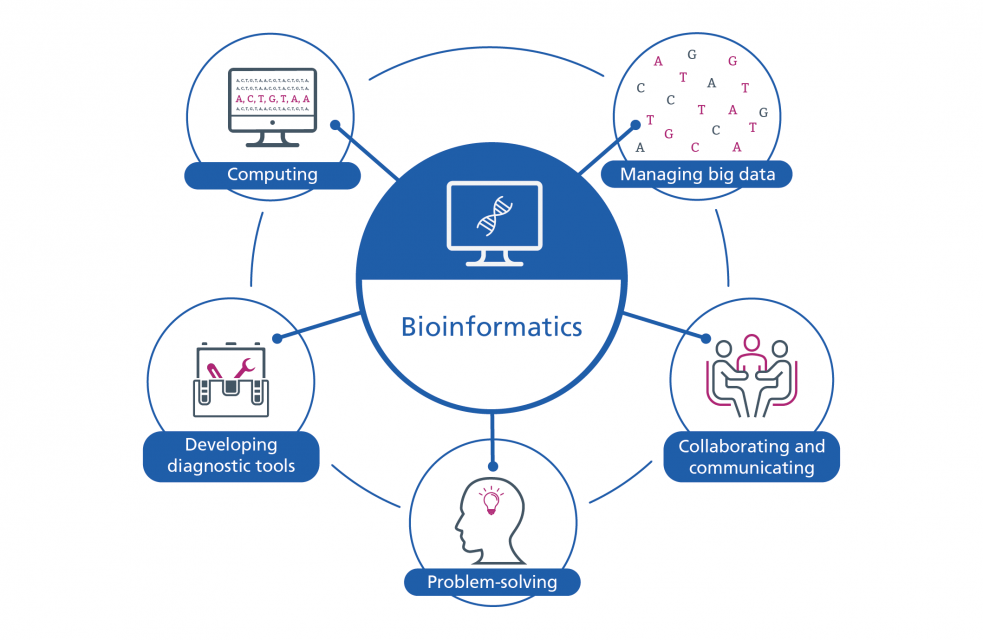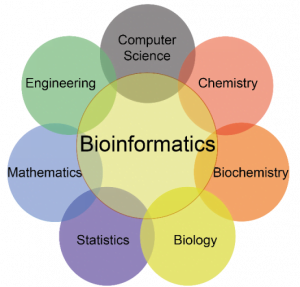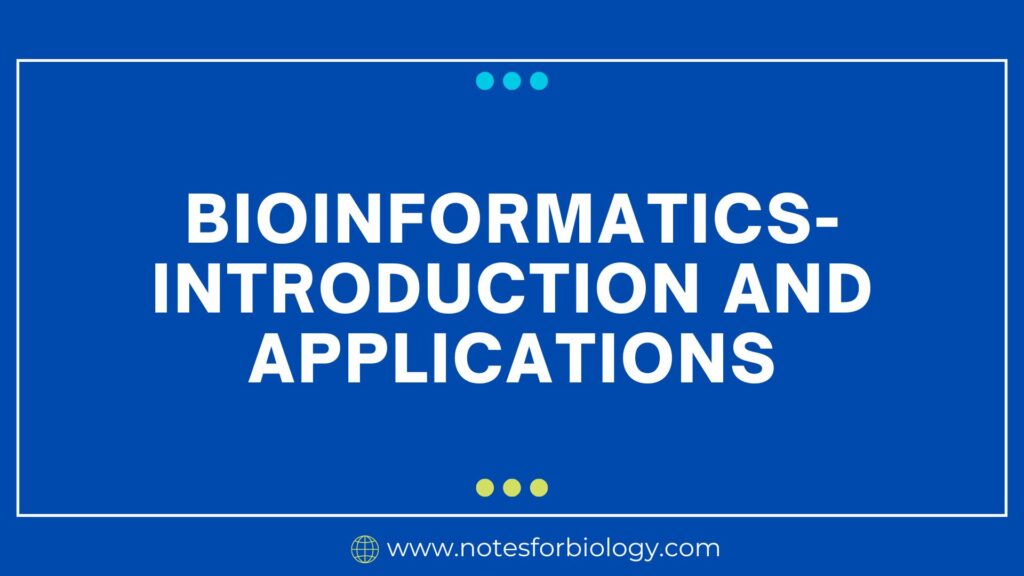Bioinformatics is a fascinating interdisciplinary field that harnesses the power of biology, computer science, mathematics, and statistics to analyze complex biological data. This includes the examination of large datasets produced by cutting-edge high-throughput experimental techniques. Bioinformatics not only involves creating and using computational tools and methods, but also delves into understanding biological processes, making predictions about protein structures and functions, and revealing intricate connections between genes, proteins, and diseases.

Table of Contents
Definition of Bioinformatics
An interdisciplinary area called bioinformatics brings together computer science, statistics, mathematics, and biology to analyze and understand biological data. It entails the creation and use of computational tools and techniques to comprehend biological processes, forecast the structures and functions of proteins, and identify connections between genes, proteins, and illnesses. A vast array of methods and strategies are included in the field of bioinformatics, such as data mining, phylogenetics, systems biology, structural biology, and sequence analysis. Its main objective is to enhance human health and extend our knowledge of living things by deriving significant insights from massive biological information produced by high-throughput experimental techniques like transcriptomics, proteomics, and genomes.

Applications of Bioinformatics
Annotation and Sequencing of Genomes
Genomes are assembled, annotated, and analyzed using bioinformatics tools. Whole-genome sequencing is one method used to comprehend the genetic composition, evolutionary history, and functional components of organisms, such as genes and regulatory sequences.
Proteomics and Predicting Protein Structure
Proteomic data analysis, such as protein identification, quantification, and characterization, is made possible by bioinformatics. Additionally, it is employed in the prediction of protein structures and functions, such as subcellular localization, post-translational modifications, and protein-protein interactions.
Alignment Sequences and Phylogenetics
Protein, RNA, and DNA sequences are compared using sequence alignment algorithms to determine evolutionary relationships as well as similarities and differences between species. Rebuilding evolutionary trees is a key component of phylogenetic analysis, which aims to comprehend the evolutionary history and relationships between organisms.
Transcriptomics and Functional Genomics
Gene expression data produced by methods like RNA sequencing (RNA-seq) and microarrays are analyzed using bioinformatics tools. This makes it possible for researchers to investigate gene regulation, find genes that express themselves differently, and comprehend biological processes at the transcriptome level.
Bioinformatics Structure and Drug Design
Protein structures are analyzed, protein-ligand interactions are predicted, and new medications are designed or old ones are made better using bioinformatics techniques. Understanding the molecular causes of diseases, virtual screening, and rational medication design are all made possible by structural bioinformatics.
Network analysis and systems biology
Utilizing bioinformatics techniques, biological data at the systems level such as signalling pathways, regulatory networks, and metabolic pathways is integrated and analyzed. Relationships between genes, proteins, and other biological entities can be found via network analysis.
Personalized medicine and medical genomics:
In medical genomics, bioinformatics is being utilized more and more to investigate genetic variants linked to illnesses, find biomarkers for diagnosis and prognosis, and create individualized treatment plans based on a person’s genetic profile.
Microbiome analysis and metagenomics
The study of genetic material extracted directly from environmental samples such as soil, water, or human microbiome is known as metagenomics. Metagenomic data is analyzed using bioinformatics techniques to examine the ecological roles and interactions of novel species, define microbial communities, and identify them.
Precision Oncology and Pharmacogenomics:
Pharmacogenomics is the study of how genetic differences affect drug reactions and how to build individualized treatment programs. Bioinformatics is a major component of this field of study. Bioinformatics is utilized in precision oncology to examine tumour genomic data to pinpoint treatment targets.
Applications in Other Fields
Molecular medicine
- The human genome will have profound effects on the fields of biomedical research and clinical medicine.
- The completion of the human genome and the use of bioinformatics tools means that we can search for the genes directly associated with different diseases and begin to understand the molecular basis of these diseases more clearly.
Personalised medicine
- Clinical medicine will become more personalised with the development of the field of pharmacogenomics.
- This is the study of how an individual’s genetic inheritance affects the body’s response to drugs.
Preventative medicine
- With the specific details of the genetic mechanisms of diseases being unravelled, the development of diagnostic tests to measure a person’s susceptibility to different diseases may become a distinct reality.
Gene therapy
- In the not-too-distant future with the use of bioinformatics tools, the potential for using genes themselves to treat disease may become a reality.
- Gene therapy is the approach used to treat, cure or even prevent disease by changing the expression of a person’s genes.
Drug development
- At present all drugs on the market target only about 500 proteins.
- With an improved understanding of disease mechanisms and using computational tools to identify and validate new drug targets, more specific medicines that act on the cause, not merely the symptoms, of the disease can be developed.
Microbial genome applications
- The arrival of the complete genome sequences and their potential to provide a greater insight into the microbial world and its capacities could have broad and far-reaching implications for environment, health, energy and industrial applications.
- For these reasons, in 1994, the US Department of Energy (DOE) initiated the MGP (Microbial Genome Project) to sequence genomes of bacteria useful in energy production, environmental cleanup, industrial processing and toxic waste reduction.
Waste cleanup
- Deinococcus radiodurans is known as the world’s toughest bacteria and it is the most radiation-resistant organism known.
- Scientists are interested in this organism because of its potential usefulness in cleaning up waste sites that contain radiation and toxic chemicals.
Climate change Studies
- Increasing levels of carbon dioxide emission, mainly through the expanding use of fossil fuels for energy, are thought to contribute to global climate change.
- Recently, the DOE (Department of Energy, USA) launched a program to decrease atmospheric carbon dioxide levels.
- One method of doing so is to study the genomes of microbes that use carbon dioxide as their sole carbon source.
Alternative energy sources
- Scientists are studying the genome of the microbe Chlorobium tepidum which has an unusual capacity for generating energy from light
Biotechnology
- The archaeon Archaeoglobus fulgidus and the bacterium Thermotoga maritima have the potential for practical applications in industry and government-funded environmental remediation.
- These microorganisms thrive in water temperatures above the boiling point and therefore may provide the DOE, the Department of Defence, and private companies with heat-stable enzymes suitable for use in industrial processes
Antibiotic resistance
- Scientists have been examining the genome of Enterococcus faecalis-a leading cause of bacterial infection among hospital patients.
- They have discovered a virulence region made up of several antibiotic-resistant genes that may contribute to the bacterium’s transformation from a harmless gut bacteria to a menacing invader.
Frequently Asked Questions
What is bioinformatics?
Bioinformatics is an interdisciplinary field that combines biology, computer science, mathematics, and statistics to analyze and interpret biological data, particularly large datasets generated by modern high-throughput experimental techniques.
How is bioinformatics used in genome sequencing?
Bioinformatics tools are used to assemble, annotate, and analyze genomes, including whole-genome sequencing of organisms to understand their genetic makeup, evolutionary relationships, and functional elements such as genes and regulatory sequences.
What is the role of bioinformatics in drug discovery?
Bioinformatics plays a crucial role in drug discovery by analyzing protein structures, predicting protein-ligand interactions, and designing novel drugs or optimizing existing ones. It is also used in virtual screening, rational drug design, and understanding the molecular basis of diseases.
Related Articles

